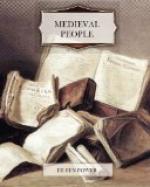For a long time historians foolishly imagined that kings and wars and parliaments and the jury system alone were history; they liked chronicles and Acts of Parliament, and it did not strike them to go and look in dusty episcopal archives for the big books in which medieval bishops entered up the letters which they wrote and all the complicated business of running their dioceses. But when historians did think of looking there, they found a mine of priceless information about almost every side of social and ecclesiastical life. They had to dig for it of course, for almost all that is worth knowing has to be mined like precious metals out of a rock; and for one nugget the miner often has to grub for days underground in a mass of dullness; and when he has got it he has to grub in his own heart, or else he will not understand it. The historians found fine gold in the bishops’ registers, when once they persuaded themselves that it was not beneath their dignity to grub there. They found descriptions of vicarages, with all their furniture and gardens; they found marriage disputes; they found wills full of entertaining legacies to people dead hundreds of years ago; they found excommunications; they found indulgences to men for relieving the poor, repairing roads, and building bridges, long before there was any poor law, or any county council; they found trials for heresy and witchcraft; they found accounts of miracles worked at the tombs of saints and even of some quite unsaintly people, such as Thomas of Lancaster, and Edward II, and Simon de Montfort; they found lists of travelling expenses when the bishops rode round their dioceses; in one they even found a minute account of the personal appearance of Queen Philippa, then a little girl at her father’s Court at Hainault, whom the Bishop of Exeter had been sent to inspect, in order to see if she were pretty and good enough to marry Edward III: she was nine years old, and the bishop said that her second teeth were whiter than her first teeth and that her nose was broad but not snub, which was reassuring for Edward.[1] Last, but not least, the historians found a multitude of documents about monasteries, and among these documents they found visitation records, and among visitation records they found Chaucer’s Prioress, smiling full simple and coy, fair forehead, well-pinched wimple, necklace, little dogs, and all, as though she had stepped into a stuffy register by mistake for the Canterbury Tales and was longing to get out again.




